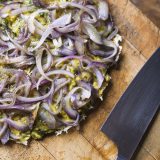The French own the omelet. Culinary students across Western Europe and America know the drill: Melt the butter. Stir the eggs while shaking the pan, then let them sit for 10 seconds. Tilt the pan to roll the omelet—first away from you, then back onto itself... Etc. Like all things French, there is a system, one that bears the weight of culinary tradition.
Yet elsewhere in the world, including the Middle East, omelets are served quite differently—open-faced, not folded—and they’re used as the base for a wide range of ingredients.
These open-faced omelets treat eggs more like a pizza onto which toppings are piled. They cook faster and easier, and it’s less about technique and more about the extras.
We start by seasoning our whisked eggs with fresh herbs and garlic, then set them aside. Toppings are cooked in the pan, then transferred to a bowl. We then wipe out the skillet and heat oil—better than butter, oil produces airy, fluffy eggs—until just smoking. (Oil heats more quickly than butter, since butter contains water that has to evaporate before the fat can rise above the boiling point.)
The eggs go in the pan and stay over the heat briefly. Off heat and covered, the eggs finish cooking in the gentle residual heat of the pan, ensuring our omelet is never overcooked and rubbery. All that’s left to do is scatter our previously cooked ingredients on top.







